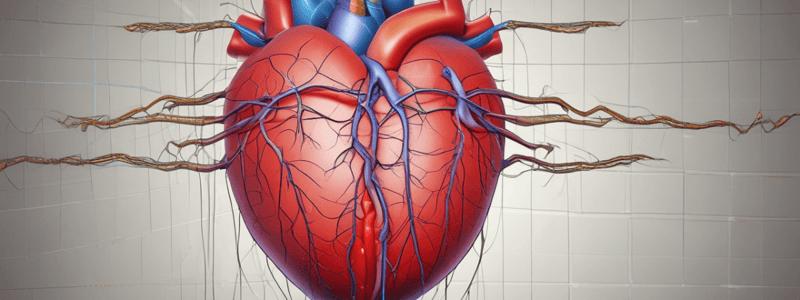Podcast
Questions and Answers
What does the cardiac cycle refer to?
What does the cardiac cycle refer to?
- The sequence of events that occur during one complete cycle of contraction and relaxation of the atria and ventricles (correct)
- The movement of blood through the pulmonary and systemic circulatory pathways
- The changes in pressure and volume within the heart
- The sequence of events that occur during one complete heartbeat
What occurs during Early Diastole?
What occurs during Early Diastole?
- The ventricles contracts and forces blood into the aorta
- The AV valves are shut, and blood is flowing from the ventricles into the atria
- The whole heart is relaxed, and the pulmonary and aortic valves are shut (correct)
- The atria contracts and forces blood into the ventricles
What is the result of atrial depolarizations?
What is the result of atrial depolarizations?
- The AV valves shut
- The pulmonary and aortic valves open
- The ventricles contract and force blood into the aorta
- The atria contracts and forces blood into the ventricles (correct)
What is the purpose of atrial systol?
What is the purpose of atrial systol?
What occurs during Isovolumetric Contraction?
What occurs during Isovolumetric Contraction?
What is the result of ventricular depolarizations?
What is the result of ventricular depolarizations?
What is represented by the P wave on an ECG?
What is represented by the P wave on an ECG?
What is the end result of atrial systol?
What is the end result of atrial systol?
Flashcards are hidden until you start studying
Study Notes
Cardiac Cycle
- The cardiac cycle refers to the sequence of events that occur during one complete cycle, including the contraction and relaxation of the atria and ventricles.
- The phases of the cycle are characterized by changes in pressure and volume within the heart, as well as the movement of blood through the pulmonary and systemic circulatory pathways.
Normal ECG Pattern
- The normal ECG pattern consists of:
- P wave
- QRS complex
- T wave
- The period of time that each cycle occurs in
Phases of the Cardiac Cycle
- Early Diastole:
- The whole heart is relaxed
- Pulmonary and aortic valves are shut
- AV valves (tricuspid and mitral) are open
- Blood is flowing passively from the great veins into the ventricles
- Atrial Systole:
- Following atrial depolarizations (P wave)
- Atria contracts, forcing blood into the ventricles
- Maximizes the volume of blood into the ventricles (end-diastolic volume)
- Atria relax
- Isovolumetric Contraction:
- Following ventricular depolarizations (the QRS complex)
- Ventricles contract, causing ventricular pressure to rise and the AV valves to shut
- Aortic and pulmonary valves are still shut, so this contraction does not bring about any change in volume
- Ventricular Ejection:
- As the pressure in the ventricles continues to rise
- Aortic and pulmonary valves are forced open and blood is rapidly ejected into the great arteries
- While the ventricles are in systole, the atria are in diastole and filling with blood
- Isovolumetric Relaxation:
- Following ventricular repolarizations (T wave)
- Ventricles relax, and ventricular pressure drops
- Blood in the aorta and pulmonary artery starts to flow back towards the heart, causing the aortic and pulmonary valves to shut
Studying That Suits You
Use AI to generate personalized quizzes and flashcards to suit your learning preferences.




